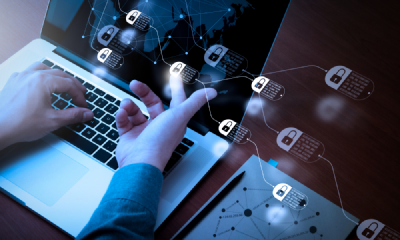Highlights:
- Blockchain is offering an alternative route for better Cybersecurity. Blockchain-based strategies are known to decrease vulnerabilities and offer reliable encryption.
- The blockchain creates a virtually impenetrable barrier between a hacker and your data, which is advantageous to the cybersecurity-warranting industries in numerous ways.
The current generation is on the cusp of wide-ranging blockchain technology applications. However, how exactly has blockchain showcased its worth in the realm of cybersecurity? Let’s get to the heart of the matter, get all the information you need right here, in this blog.
The demand for robust cybersecurity infrastructure has increased exponentially in the past decade and this enterprise need only continues to rise. More so, given the fact that no cyber defense or data system can be considered 100% secure! In fact, cyberattacks have become more targeted and complex due to the increasing high-tech malware and the threat posed by professional cyberhacking organizations.
As confirmed by Check Point Research (CPR), global attacks have increased by 28% in the third quarter of 2022 as compared to the same time period in 2021. The global average weekly number of attacks per organization has surpassed 1,130!
We are all aware of the popularity, and traction blockchain technology has gained in the market. As with other systems, organizations using blockchains must adopt cyber security controls and standards to protect themselves from external attacks, despite the fact that some of blockchain’s underlying capabilities provide data confidentiality, integrity and availability.
Despite its purported security benefits, the blockchain market has been plagued by security issues; cryptocurrency-related crimes have resulted in over $14 billion in losses in 2021, an increase of nearly 57% from the previous year.
So, what about the role of blockchain in cybersecurity? Will the technology help or hinder cyber security? Let’s take an overview of the groundbreaking introduction of blockchain in cyber security.
Pros: The evolved cybersecurity approach with blockchain shield
As a blockchain-led platform can secure, prevent fraudulent activities through consensus mechanisms; and detect data tampering based on its immutability, transparency, auditability, data encryption and operational resilience, blockchains can help improve cyber defense.
Blockchain offers an alternative route for better cybersecurity. The blockchain strategy decreases vulnerabilities and offers reliable encryption. Additionally, this methodology successfully confirms the ownership and integrity of data. Even the requirement for passwords, the cybersecurity system’s weakest link, is removed.
Cons: Blockchain security issues are abound
Is blockchain the perfect solution for all your cybersecurity concerns? Alas! It’s not. Here is the reason why. Cybercriminals are intelligent enough to exploit blockchain’s vulnerabilities in various ways and wreak havoc and catastrophic enterprise damage.
Governments and international organizations today consider blockchain-based cybersecurity the next big thing and are eager to adopt it. However, it is more challenging than just upgrading an existing security toolset.
This strategy of combining blockchain with cybersecurity is still in its development phase. Not all research concepts on digital identities, decentralized storage, safeguarding edge devices and smart contracts are compatible with the commercial requirements. For blockchain to succeed in cybersecurity, its careful study and implementation are essential.
While adopting blockchain-based procedures, firms do confront the numerous blockchain security issues. When considering blockchain as a component of their cybersecurity strategy, enterprises may face the following roadblocks.
Data privacy: Anyone may access transaction data in the public blockchain. Businesses that seek to regulate public information are not compatible with this fact.
Permissioned blockchain can aid with privacy. A blockchain platform for businesses may build a permissible network where only responsible parties can view and vote on transactions.
Scalability: Block size and response time hinder blockchain’s scalability. Each node records, processes and retains transactions in a block to ensure security and anonymity. As the volume rises, small and medium-sized enterprises struggle to accommodate more transactions in each block. It increases slow validation: there is scalability and decentralization conflict with limited computational and storage resources.
Regulations: It is challenging to adapt to and comprehend how blockchain’s structure and complexity fit into the developing data privacy, compliance and regulatory environment. In addition, legislation such as Europe’s General Data Protection Regulation (GDPR) permits individuals to request that their data be destroyed.
Blockchain cybersecurity use cases
The blockchain creates a virtually impenetrable barrier between a hacker and your data, which is advantageous to the cybersecurity-warranting industries in numerous ways. Blockchain in Cybersecurity is thus still widespread, inspite of the cons. We have listed four categories of blockchain cybersecurity use cases for your review.
Decentralization guarantees resilience and availability
Blockchain safeguards sensitive data by guaranteeing a decentralized approach for data storage. This countermeasure would make it difficult, if not impossible, for hackers to breach data storage systems.
The best aspect of decentralized infrastructure is that it promotes resistance to attacks, corruption and downtime. The decentralization process protects against the following risks:
- Distributing information and communications technology networks reduces data exposure and reroutes users when a centralized database is unavailable or under attack.
- In the event of a denial-of-service (DDoS) attack, DNS decentralization provides redundancy.
- Distributing operations and administrative controls away from a central hub in an IoT context enables security decisions to be made closer to the network’s edge.
The integrity of data transmitted through blockchain
Don’t you seek to protect your data transmission process? Here is where the blockchain plays a crucial role in preventing unauthorized access to data while in transit. Using the technology’s feature for complete encryption, data transmission can be protected against malicious intrusion.
Voting, health and scientific data collaboration across institutions and industries, as well as decentralized metadata, are crucial for optimizing AI in cybersecurity. These are three examples of emerging blockchain designs for data integrity applications.
“Blockchain technology can’t solve for the human factor. If someone inputs garbage data onto a blockchain, that garbage is recorded forever and can inadvertently become a flawed source of truth. Thus, an analysis of data hygiene is a critical precursor to any blockchain deployment.” – Sheila Warren, Platform Head – Blockchain, Digital Currency, and Data Policy, World Economic Forum.
Upholds provenance, traceability and transparency
When blockchain is designed, transparency and traceability are the core factors that are considered. However, the advantages of its security vary depending on the application.
A digital ledger holds tamper-proof records of transactions and hashes related to the supply chain. Since the data stored in blockchain technology is immutable and cannot be altered, it may effectively confirm the software’s integrity. In light of this, we conclude that blockchains can enhance the security and privacy of transactions like remittances and international payments.
Authentication of cyber-physical Infrastructure
The integrity of data produced by cyber-physical systems has been compromised by data manipulation and system misconfiguration. However, the effectiveness of blockchain technology in ensuring the integrity and veracity of data may be leveraged to validate the state of cyber-physical infrastructure.
Several blockchain components may be applied to identity protection, authentication and access management, among other uses. The multiple security benefits of these skills are as follows:
- Sensitive data protection
- Identity theft prevention
- Data minimization
- Multisignature access controls and decentralized administration
Blockchain in cyber security – real examples of effective applications
Take a look at some of the prominent examples of implemented blockchain in cyber security from some of the world’s leading brands.
Barclays: Barclays is a leading traditional financial bank in London. Barclays has filed a patent to improve the security of fund transfers using blockchain technology. Using the Distributed Ledger Technology, it aims to stabilize cryptocurrency transactions. Consequently, blockchain enables the bank to store customer data on a secure blockchain.
CISCO: Using blockchain for cyber security in the IoT sector at Cisco has led to yet another success story. Cisco intends to use blockchain to secure IoT devices, as distributed ledger technology eliminates single points of failure and the encryption aids in data security.
Blockchain’s future potential in cybersecurity
Digitization and resilience are imperative in a more complex and unpredictable world. Companies are keen on cumulating security and visibility with privacy and good governance. The answer to this comprehensive search is blockchain in cybersecurity.
Security leaders must understand the benefits and risks of blockchain in cybersecurity before leveraging them to foster trust in the digital world. No matter how it is utilized, the key component of blockchain technology is its ability to decentralize.
Blockchain may be one of the most effective cyber threat mitigation strategies. In spite of what preceded, blockchain, like any other new technology, is encountering many groundwork challenges as it is undergoing the painful process of growth.













